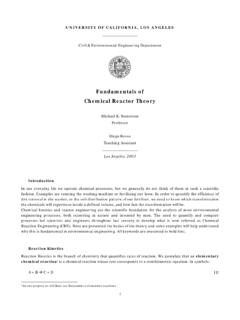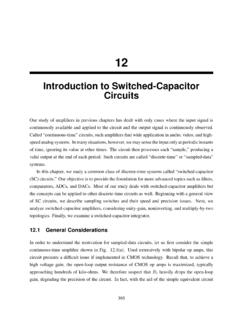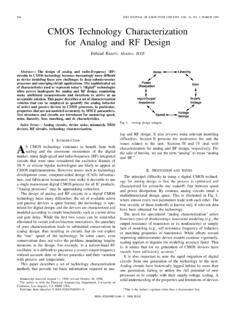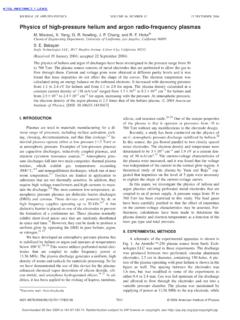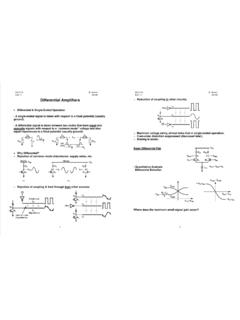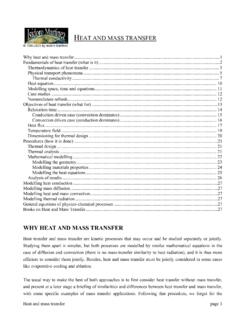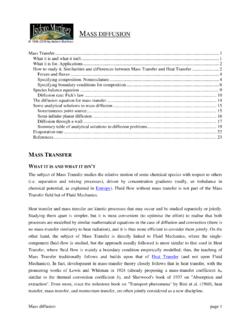Transcription of International Journal of Heat and Mass Transfer - …
1 Scaling laws for heat generation and temperature oscillations in EDLC sunder galvanostatic cyclingAnna d Entremont, Laurent Pilon University of California, Los Angeles, Henry Samueli School of Engineering and Applied Science, Mechanical and Aerospace Engineering Department,420 Westwood Plaza,Los Angeles, CA 90095, USAarticle infoArticle history:Received 23 December 2013 Received in revised form 19 March 2014 Accepted 1 April 2014 Keywords:SupercapacitorsEnergy storageJoule heatingReversible heatingDimensional analysisabstractThis study provides a framework for developing design rules and thermal management strategies forelectric double layer capacitors (EDLCs). First, it presents a scaling analysis of a physical model previouslyderived from first principles for coupled electrodiffusion and thermal transport in electric double layercapacitors.
2 The model rigorously accounts for irreversible (Joule heating) and reversible heat generationrates arising from electric double layer formation in binary and symmetric electrolytes. Scaling simplifiedthe problem from twelve independent design parameters to seven meaningful dimensionless similarityparameters governing the spatiotemporal evolution of the electric potential, ion concentrations, heatgeneration rates, and temperature in the electrolyte. Then, similarity behavior was observed and scalinglaws were developed for the total irreversible and reversible heat generated during a charging step andfor the maximum temperature oscillations in EDLCs under galvanostatic cycling of planar electrodesusing detailed numerical simulations. 2014 Elsevier Ltd.
3 All rights IntroductionElectric double layer capacitors (EDLCs) are devices that storeelectrical energy within the electric double layer (EDL) formingat the porous electrode/electrolyte interfaces. Their energy andpower densities lie between those of batteries and those of conven-tional dielectric capacitors[1 3]. EDLCs use physical charge stor-age, in contrast to chemical energy storage used in batteries. Thistypically yields significantly larger power densities, longer cyclelife, and higher cycle efficiencies than batteries[1,3]. In addition,EDLCs use porous electrodes with very small charge separation dis-tances to achieve larger energy densities than dielectric capacitors[1 3]. EDLCs are promising for applications requiring high power,rapid cycling, and long cycle life such as load leveling, regenerativebraking, and dynamic stabilization of the utility grid[2,4 7].
4 During EDLC operation, some electrical energy is dissipated asheat. The device efficiency and the heat generation rate vary withthe cell design, materials, and operating conditions[4]. Tempera-ture rise increases EDLC capacitance and decreases the resistance[8 10]. However, it also accelerates EDLC aging[4 7,10,11], andincreases self-discharge rates[5 7,10]. EDLC aging permanentlyincreases the cell s resistance and decreases its capacitance, whichin turn leads to increases in cell temperature and in cell voltage at agiven state of charge[11]. Non-uniform temperature in series-con-nected EDLC modules can cause voltage imbalance and destructiveovervoltage of individual cells[4,7]. A 20% decrease in capacitanceor a 100% increase in internal resistance typically define the end oflife for an EDLC[12].
5 These damaging effects could be avoided bymitigating EDLC temperature rise. To do so, thermal modelingcan be used (i) to predict operating temperatures of existing andnovel EDLC designs and (ii) to develop thermal management strat-egies for study aims to develop a theoretical framework and practi-cal scaling laws to derive rules in the thermal design and manage-ment of EDLCs. To do so, scaling analysis was performed on arecent thermal model of EDLCs derived from first principles[13].The first objective was to reduce the number of design parametersto a few meaningful dimensionless similarity parameters govern-ing the thermal behavior of EDLCs. Then, scaling laws for the heatgeneration rate and the temperature rise in the electrolyte ofEDLCs were developed for planar Structure of the electric double layerFig.
6 1(a) illustrates the Stern model[14,15]of an electric doublelayer (EDL) forming near a planar electrode. The EDL within 2014 Elsevier Ltd. All rights reserved. Corresponding author. Tel.: +1 (310) 709 Pilon). International Journal of heat and mass Transfer 75 (2014) 637 649 Contents lists available atScienceDirectInternational Journal of heat and mass Transferjournal homepage: is divided into the Stern and diffuse layers. The Sternlayer is defined as the compact layer adjacent to the electrode sur-face with no free charge[3,14,15]. In the diffuse layer, ions moveunder the coupled influences of electrostatic forces and diffusion[3,14,15]. The EDL thickness depends on the electrolyte concentra-tion, valency, and temperature[14,15]. First-principles modeling of EDLC transport phenomenaIn a recent study[13], we developed a thermal model predictingthe local heat generation rate and temperature within EDLC elec-trolyte.
7 The energy conservation equation was derived from firstprinciples and coupled to the modified Poisson Nernst Planck(MPNP) model governing the local electric potential and ion con-centrations[16]. Both were valid for binary and symmetric electro-lytes, , for only two ion species with identical valencyz,diffusion coefficientD, and effective diametera[16]. Note thatsymmetric electrolytes have also been defined based on symmetricvalency alone, ,z1 z2, without considering the ion diameteror the diffusion coefficient[1,14,15]. However, microscopic modelsaccounting for transient ion transport and finite ion size require amore restrictive definition of electrolyte symmetry. The thermalmodel was derived based on the thermodynamic activity coeffi-cients of the ion species given by the Debye H ckel limiting law[17,18].
8 Electric potential and ion concentrationsThe local electric potential and ion concentrations in the elec-trolyte can be predicted by solving the modified Poisson Nernst Planck (MPNP) model accounting for the Stern layer and the finitesize of ions[13,16]. The electric potentialw r;t at locationrandtimetis governed by the Poisson equation expressed for binaryelectrolytes as[13,16,19,20]r 0 rrw 0in the Stern layers; FX2i 1ziciin the diffuse layer;8> <>: 1 whereci r;t andzidenote the concentration and valency of ionspeciesi, respectively. For binary and symmetric electrolytes,z1 z2 zwhere subscriptsi 1 andi 2 denote cations andanions, respectively. Here, 0 8:854 10 12F mol 1and rarethe vacuum permittivity and the relative permittivity of the electro-lyte, respectively, whileF 9:648 104C mol 1is the Faraday con-stant.
9 Note that the potential profile within the Stern layers is lineardue to the absence of free charge. In the diffuse layer, the local con-centrationsc1 r;t andc2 r;t satisfy the mass conservation equa-tion given by[16]@ci@t r Nifori 1 and 2; 2 whereNi r;t is the local ion flux vector of speciesiin mol m 2s binary and symmetric electrolytes, it is expressed as[16]Ni r;t Drci ziFDRuTcirw Da3 NAci1 a3NA c1 c2 r c1 c2 "#; 3 where the first, second, and third terms on the right-hand side of Eq.(3)account for diffusion, electromigration, and steric effects,respectively. The steric term prevents the total ion concentration c1 c2 from exceeding the theoretical maximum concentrationcmax 1=NAa3corresponding to simple cubic packing of ions. Here,Dis the diffusion coefficient of ions in the electrolyte,ais theireffective diameter,Ru 8:314 J mol 1K 1is the universal gas con-stant, andNA 6:022 1023mol 1is the Avogadro constant.
10 Eqs.(1) and (2)are intimately coupled because the potential profileNomenclatureAsemi-empirical fitting functionaeffective ion diameterBsemi-empirical fitting functionC dimensionless heat capacitycion concentrationcmaxmaximum ion concentration,cmax 1=NAa3cpspecific heat of the electrolyte at constant pressureDdiffusion coefficient of ions in electrolyteeelementary charge,e 1:602 10 19 Ceththermal effusivity,eth kqcp 1=2 FFaraday constant,F eNA 9:648 104C mol 1 HStern layer thicknessjionic current density vectorjsmagnitude of current density imposed at electrode sur-facekthermal conductivity of electrolyteLhalf of inter-electrode distanceLeLewis number,Le a=DNAA vogadro constant,NA 6:022 1023mol 1 Niion flux vector of speciesinccycle numberQamount of heat generated per charging step per unitsurface area_qlocal volumetric heat generation rateRuuniversal gas constant,Ru 8:314 J mol 1K 1rlocation vector in three-dimensional spaceTlocal, absolute temperatureT0initial temperaturettimetccycle periodxlocation in one-dimensional spacezion valencyGreek symbolsathermal diffusivity,a k=qcp 0vacuum permittivity, 0 8.
